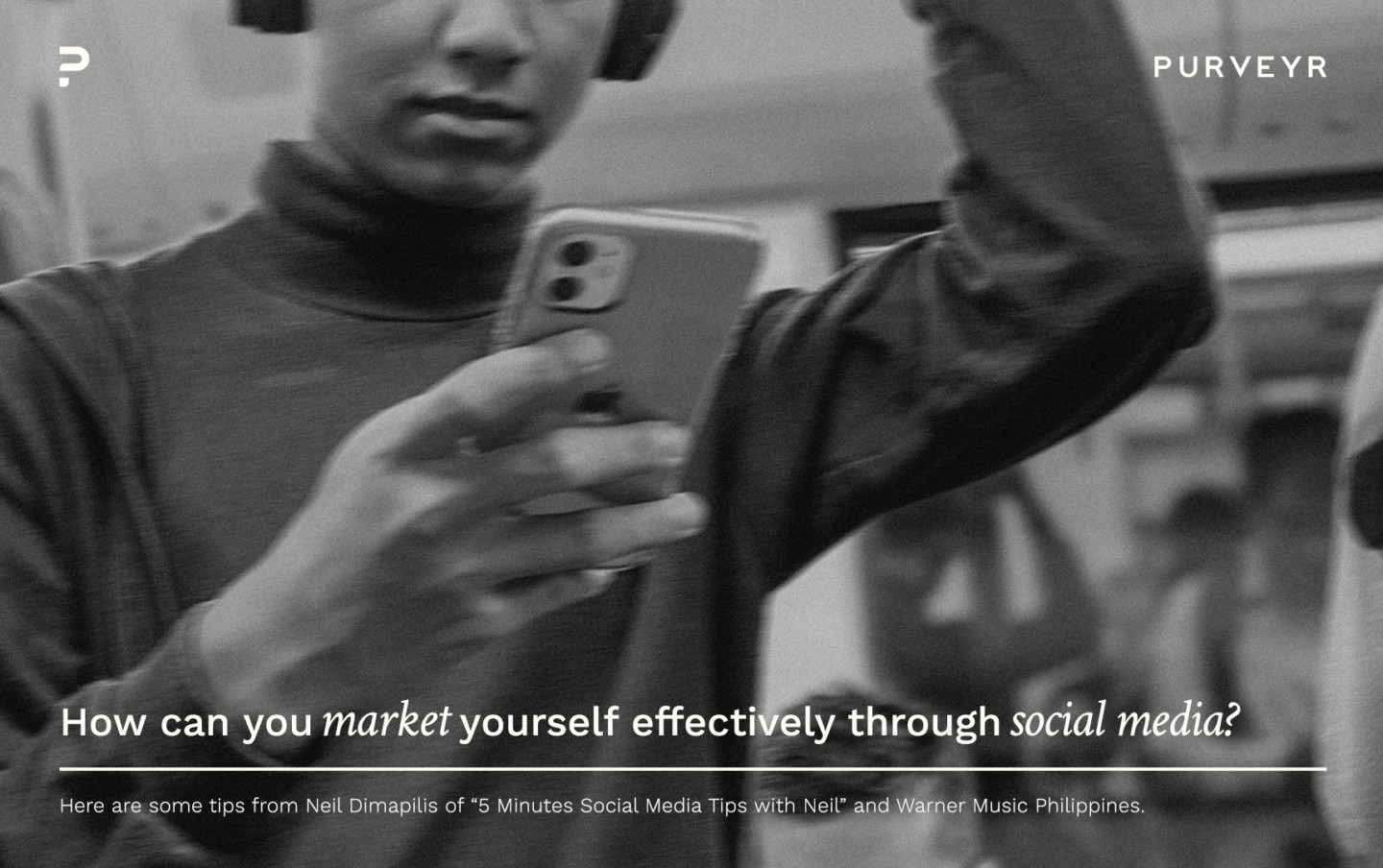
Getting a foothold on social media when you are a starting creative, brand, or business can feel like the wild west. It has become such a crucial space to play in. Having an innovative product or service is only half the battle.
With the plethora of businesses vying for everyone’s attention online, there’s a tendency for brands to look the same, making it hard to stand out. And even if you have been lurking the web before starting your business, there is no guarantee this would translate to a successful online presence.
What does it take to market yourself effectively, then? We asked Neil Dimapilis—the brain behind the 5 Minutes Social Media Tips with Neil podcast and a social media marketing service provider whose work includes The Dessert Museum, Ethan Cash Sneaker Cleaning Store, Bai’s Cebu Boneless Lechon, Good Guys Clothing, and, most notably, Warner Music Philippines—on how you as a creative or business owner can market yourself effectively through social media.
What not to do on social media
The first thing to remember is winning the social media game is not as easy as it seems. It’s not simply about posting, liking, and commenting. And it’s not a race to get them, either. Despite what other experts may advertise, there is no quick and easy way to garner a certain number of followers and engagements. “It’s something that you need to prepare for, something that you need to invest in,” says Neil.
In fact, getting your brand out online isn’t so different from getting it out traditionally. Before setting up your personal or business page, Neil advises identifying who your audience is. This will help you determine “where your tone of voice on social media will come from” and “how your social content would look like,” among other things.
It might be tempting to jump on the trendy platforms (like TikTok) thinking it will automatically get you the clients you need. It is not always the case. Much like how setting up shop isn’t going to guarantee you customers, online, you’ll need to have the business skills—such as targeting, networking, and customer service—to find, get, and close clients.
The second thing to remember is that social media is a social platform—they’re a bridge to get sales, not a guarantee. And that means getting the return on investment takes longer. If your purpose for getting into social media marketing is to sell, you’ll only end up frustrated. “The earlier you realize that, the more money you save,” he says.
Consistency wins the race
All this considered, what’s a more effective way to use it? Focusing on your content, regardless of platform or user trends. Different platforms attract different demographics, according to Neil, but just because one platform succeeds more doesn’t mean you should abandon the others altogether. “At the end of the day people are searching for you anywhere they can search you, so being visible wherever is a big win,” he says.
More importantly, posting consistently will help you give your business the visibility it needs. While some would argue that the date and time of posting matter, Neil notes that it varies.
“Overall engagement and reach is a very subjective matter… I suggest they experiment on this one. Because there is no one-size-fits-all strategy for the day, time, and regularity of posting that assures high reach and engagement,” he says. “Since social media or digital in general is very fast-paced, always keep in mind that what works now may not work tomorrow, next week, next month, or next year! So adapt and experiment in different ways you think would best work for you.”
When creating social media content, focusing on what is easy to consume and relevant to your target market will help gain you momentum. The online arena moves fast, so resonating with your audience on a personal level is essential. “People miss going out, people miss having that sense of connection with other people,” says Neil.
On the organic front—meaning content that has not been paid for—this can mean “Facebook Groups or community strategies like starting a Viber community or Discord server” which Neil notes is “something that’s thriving right now… and has been evident in several industries.”
Play the “pay game”
But organic posts only account for part of the strategy. Neil notes that social media today is a “pay to play” game—to be visible to your target audience, you do need to boost your posts.
“Boosting content on social media is one of the key practices that you should learn no matter the platform,” Neil says. “ When you are not boosting or running ads for your social media pages and accounts, you are just tapping a fraction of your desired target market. And those desired audiences will have a hard time finding you, especially with all the noise out there on social media.”
Having a successful paid strategy isn’t just about targeting everyone, however. On the contrary, targeting on a large scale initially can do more harm than good. When starting, Neil instead advises tapping into the local market first. “Your initial market should be the one where you are located,” he says. “Optimize them as your audience ad sets. Then as you grow, you can use them to create more look-a-like audiences—wherein their behaviors, interactions, and interests are the ones that perfectly fit the description of your desired target market.”
To further tap into your audience, Neil also advises joining Facebook communities and niche Facebook groups that will allow you to “share, sell, impart products, services, and information” to those already within your local community.
Finally, when choosing between creating ads with a specific goal versus merely boosting organic posts, Neil says both are okay. They just serve a different purpose.
For him, ads with specific goals allow you to be more creative with the content you boost and lets you explore different types of goals. These goals can range anywhere from website traffic for your e-commerce platform to a simple reach and brand awareness campaign. On the other hand, boosting an already existing post can be great for garnering additional engagement but does not allow you to choose ad types or new creatives.
The bottomline
Overall, when planning for a successful social media strategy, it’s important to know the needs of your brand and business—particularly your goals for it. “Before wanting to have success, they must first define how they want to define success,” Neil says. Whether that’s link clicks or engagements, knowing this allows you to see how effective your social media strategy is.
Winning the social media game when you are new can seem like a waiting game at times. But with the right amount of patience and effort, it can pay off big time. Remember: social platforms are not so much a sprint as they are a marathon. And those who plan best often land first.
—
You can listen to Neil’s Social Media podcast here to learn more about the topic.
SUPPORT PURVEYR
If you like this story and would love to read more like it, we hope you can support us for as low as ₱50. This will help us continue what we do and feature more Filipinos who create. You can subscribe to the fund or send us a tip.




